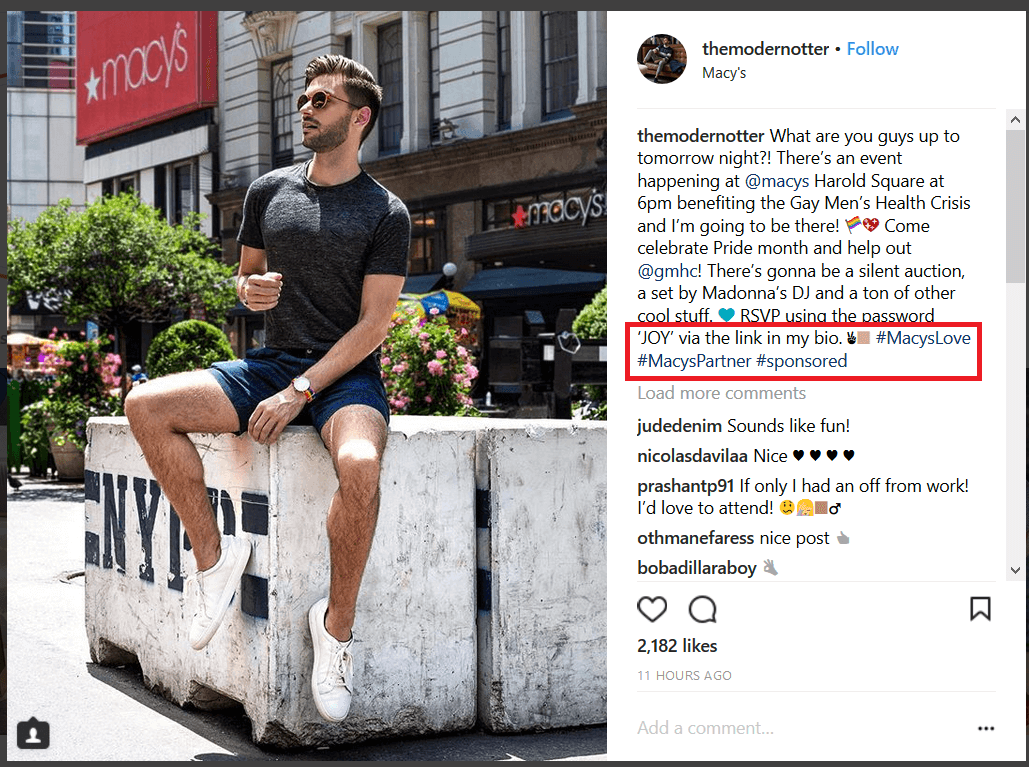Just a decade or two ago, you could not watch even ten minutes of a TV show without being interrupted by an ad.
Then services such as DVR, on-demand streaming and adblockers came to life, enabling you to have an ad-free experience when consuming content. With the right tools, ads disappeared.
And yet, ads are now coming back in full swing. Just in a way we’ve never seen before: influencer marketing.
Influencer marketing – paid promotion of your product by people trusted by your target market – has taken the digital marketing world by storm.
It is currently one of the top performing ways to promote your products and content on social media, and offers an awesome return on your ad investment.
This article will give you a great foundation in influencer marketing, enabling you to use it to drive traffic and sales from social media.
Stay compliant
One of the biggest influencer marketing blunders is not disclosing that an influencer is being compensated for promotion. Although some influencers (and brands) may be uncomfortable disclosing this information, it is necessary by law.
According to the Federal Trade Commission’s Endorsement Guides, every time there is reimbursement for a promotion between an influencer and advertiser, this should be clearly stated.
To show that they’re not taking this lightly, the FTC sent out more than 90 letters of warning to various Instagram influencers a little over a year ago. In September of 2017, they went after two YouTube influencers who settled the complaint.
The good news is that not only brands will take responsibility for complacency. The bad news is, all influencer marketing efforts will soon be under the scrutiny of law.

If you’re wondering what it takes to abide by the law – it’s fairly simple. For platforms such as Instagram, Facebook or Twitter, it’s enough to post hashtags such as #paid, #ad, #sponsored or #brandambassador at the beginning of each post. It’s also handy to point out the paid promotion in the body of the post as well. It is not advisable to use tags such as #collaboration or #partner, or any other tag that can be ambiguous and misinterpreted. For blogs, clearly state that the content is paid to promote. When it comes to video, make sure to verbally point out the relationship with the advertiser. Compliance rules differ across platforms, and it’s worth taking time to get familiar with them.
If you’re an influencer, it’s up to you to be informed and stay compliant with FTC regulations, ensuring fruitful (and legal) collaboration with your partners. If you’re working with an influencer, make sure that they have a track record of following FTC regulations before entering into an agreement. It also doesn’t hurt to check every paid post for appropriate wording, as your influencer may not be complying, (un)intentionally.
Carefully select your influencer
One of the biggest mistakes with influencer marketing is simply going for whichever influencer is popular at the moment and has lots of followers. Others simply look at the big picture – hiring a beauty blogger to pitch a beauty product, for example.
In order to truly resonate with your target audience, you need to ensure that the message is authentic. In other words, would the influencer represent your product even if they weren’t paid to do so? Followers can pick up if a promotion is not sincere – your brand needs to be in line with their previous social media presence.
Most importantly, you need to do some proper research to find out if their values are in line with yours. Customers will associate your brand with that influencer, so it’s crucial to learn their beliefs, values and attitudes, in order to avoid negative publicity later on. Simply scroll through their feed and see if it is the kind of person you want being the voice of your brand.
Venture outside of Instagram
When they hear the term influencer marketing, most people think of Instagram nowadays. Rightly so, as 91,5% of currently active influencers choose Instagram as their platform of choice. It’s no wonder that this is the case, as it has more than 800 million active monthly users at the moment, steadily going for 1 billion by end of 2018.
There seems to be a noticeable shift in platform for influencer digital marketing. It gained traction through blogs, moved to YouTube and finally to Instagram. However, Instagram is not the only platform for influencers, and trends may change yet again, with some other lead generation platform becoming prevalent.
The primary reason to go beyond Instagram is price. As the demand grows higher, Instagram influencers ramp up their fees. While we can’t give you a precise figure, there is some research available to give you a good estimate.
Namely, 66% of brands report paying under $250 for a single promoted post, while 27% pay anywhere from $250 do $1000 for a post by an influencer. Depending on what kind of ROI you are expecting, influencers on Instagram can get quite costly.
At the same time, you need to research where your target audience spends their time, which may not always be Instagram. The influencer may have a smaller following on other social networks and charge less there. Additionally, they may have more of an engaged following on Pinterest, YouTube or Facebook, even though it is smaller in numbers.
Related Content
- 7 Ways to Find Influencers in Any Niche
- 9 Surprising Ways You Can Use YouTube for Influencer Marketing
- Influence Marketing: How to Build Relationships with Social Leaders and Drive Traffic to Your Blog
- Demystifying Your First Influencer Marketing Campaign
Measure your influencer marketing efforts
While having an influencer show your product in a post is a really cool thing to have, it does not show you any actual return on investment. For 78% of marketers, measuring ROI on influencer marketing is one of their top challenges in 2017.
Even though it is not so easy to track compared to banner advertising, for example, it’s definitely manageable to track your ROI. You can measure success by reach, engagement, social sentiment and conversions.
Reach is one of the most essential metrics for tracking campaign success, it’s simply how many people viewed your post. While you can easily see it on YouTube, Facebook and Instagram videos, for all other types of posts you have to make an estimate. Reach largely depends on the number of followers an influencer has.
Engagement is more relevant than reach, as it shows how many people interact with a post, instead of how many just viewed it. A post can get a lot of views thanks to large follower numbers but simply get no traction because it’s irrelevant to the target audience. You can track engagement through likes, comments, favorites, shares and mentions.
What’s more difficult to track is social sentiment. This is essentially how the influencers’ followers feel about a post. You can track this through comments or like/dislike ratios on platforms such as YouTube.
Finally, conversions are the best way to measure your influencer marketing ROI. You can measure anything from sales, clicks, downloads, email signups, traffic to your website and much more. Only through measuring conversions can you effectively see your cost per acquisition.

You can track conversions in many ways, with UTM parameters being one of the most reliable methods. Alternatively, you can set up a special discount code for an influencer in order to track how many sales you’re able to get through a certain campaign.
Whether you like it or not, influencer marketing is here to stay. As more and more brands start recognizing the value of building meaningful relationships through influencers, influencer marketing is bound to become a pivotal marketing strategy across industries. Using these bits of advice, you’re sure to make your next influencer marketing campaign a success.
About the author:

Dave Schneider is the founder of LessChurn, a churn reduction app. In 2012 he quit his job to travel the world, and has visited over 65 countries. In his spare time, he writes about SaaS and business at DaveSchneider.me.

